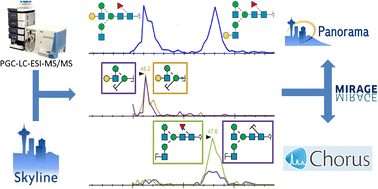Journal of the American Society for Mass Spectrometry ( IF 3.2 ) Pub Date : 2018-03-30 , DOI: 10.1007/s13361-018-1932-z Christopher Ashwood 1, 2 , Chi-Hung Lin 1, 3, 4 , Morten Thaysen-Andersen 1 , Nicolle H. Packer 1, 2, 4
Profiling cellular protein glycosylation is challenging due to the presence of highly similar glycan structures that play diverse roles in cellular physiology. As the anomericity and the exact linkage type of a single glycosidic bond can influence glycan function, there is a demand for improved and automated methods to confirm detailed structural features and to discriminate between structurally similar isomers, overcoming a significant bottleneck in the analysis of data generated by glycomics experiments. We used porous graphitized carbon-LC-ESI-MS/MS to separate and detect released N- and O-glycan isomers from mammalian model glycoproteins using negative mode resonance activation CID-MS/MS. By interrogating similar fragment spectra from closely related glycan isomers that differ only in arm position and sialyl linkage, product fragment ions for discrimination between these features were discovered. Using the Skyline software, at least two diagnostic fragment ions of high specificity were validated for automated discrimination of sialylation and arm position in N-glycan structures, and sialylation in O-glycan structures, complementing existing structural diagnostic ions. These diagnostic ions were shown to be useful for isomer discrimination using both linear and 3D ion trap mass spectrometers when analyzing complex glycan mixtures from cell lysates. Skyline was found to serve as a useful tool for automated assessment of glycan isomer discrimination. This platform-independent workflow can potentially be extended to automate the characterization and quantitation of other challenging glycan isomers.

ᅟ
中文翻译:

释放的异构体的歧视
由于高度相似的聚糖结构在细胞生理学中起着不同的作用,因此分析细胞蛋白糖基化具有挑战性。由于单个糖苷键的异头异构性和确切的连接类型会影响聚糖功能,因此需要一种改进的自动化方法来确认详细的结构特征并区分结构相似的异构体,从而克服了在分析生成的数据时遇到的重大瓶颈通过糖组学实验。我们使用了多孔石墨化碳-LC-ESI-MS / MS来分离和检测释放的N-和O哺乳动物模式糖蛋白的β-聚糖异构体,采用负模式共振激活CID-MS / MS。通过从仅臂位置和唾液酸键不同的密切相关的聚糖异构体中查询相似的碎片光谱,发现了用于区分这些特征的产物碎片离子。使用Skyline软件,验证了至少两个高特异性诊断片段离子可自动区分N-聚糖结构中的唾液酸化和臂位置以及O中的唾液酸化-聚糖结构,可补充现有的结构诊断离子。在分析来自细胞裂解液的复杂聚糖混合物时,使用线性和3D离子阱质谱分析仪显示这些诊断离子可用于识别异构体。人们发现Skyline可作为自动评估聚糖异构体歧视的有用工具。这种独立于平台的工作流程可以潜在地扩展,以自动进行其他具有挑战性的聚糖异构体的表征和定量。

ᅟ



























 京公网安备 11010802027423号
京公网安备 11010802027423号